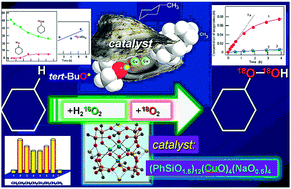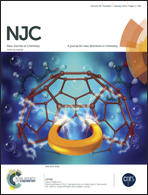Abstract
Isomeric cage-like tetracopper(II) silsesquioxane complexes [(PhSiO1.5)12(CuO)4(NaO0.5)4] (1a), [(PhSiO1.5)6(CuO)4(NaO0.5)4(PhSiO1.5)6] (1b) and binuclear complex [(PhSiO1.5)10(CuO)2(NaO0.5)2] (2) have been studied by various methods. These compounds can be considered as models of some multinuclear copper-containing enzymes. Compounds 1a and 2 are good pre-catalysts for the alkane oxygenation with hydrogen peroxide in air in an acetonitrile solution. Thus, the 1a-catalyzed reaction with cyclohexane at 60 °C gave mainly cyclohexyl hydroperoxide in 17% yield (turnover number, TON, was 190 after 230 min and initial turnover frequency, TOF, was 100 h−1). The alkyl hydroperoxide partly decomposes in the course of the reaction to afford the corresponding ketone and alcohol. The effective activation energy for the cyclohexane oxygenation catalyzed by compounds 1a and 2 is 16 ± 2 and 17 ± 2 kcal mol−1, respectively. Selectivity parameters measured in the oxidation of linear and branched alkanes and the kinetic analysis revealed that the oxidizing species in the reaction is the hydroxyl radical. The analysis of the dependence of the initial reaction rate on the initial concentration of cyclohexane led to a conclusion that hydroxyl radicals attack the cyclohexane molecules in proximity to the copper reaction centers. The oxidations of saturated hydrocarbons with tert-butylhydroperoxide (TBHP) catalyzed by complexes 1a and 2 exhibit unusual selectivity parameters which are due to the steric hindrance created by bulky silsesquioxane ligands surrounding copper reactive centers. Thus, the methylene groups in n-octane have different reactivities: the regioselectivity parameter for the oxidation with TBHP catalyzed by 1a is 1 : 10.5 : 8 : 7. Furthermore, in the oxidation of methylcyclohexane the position 2 relative to the methyl group of this substrate is noticeably less reactive than the corresponding positions 3 and 4. Finally, the oxidation of trans-1,2-dimethylcyclohexane with TBHP catalyzed by complexes 1a and 2 proceeds stereoselectively with the inversion of configuration. The 1a-catalyzed reaction of cyclohexane with H216O2 in an atmosphere of 18O2 gives cyclohexyl hydroperoxide containing up to 50% of 18O. The small amount of cyclohexanone, produced along with cyclohexyl hydroperoxide, is 18O-free and is generated apparently via a mechanism which does not include hydroxyl radicals and incorporation of molecular oxygen from the atmosphere.


 Please wait while we load your content...
Please wait while we load your content...